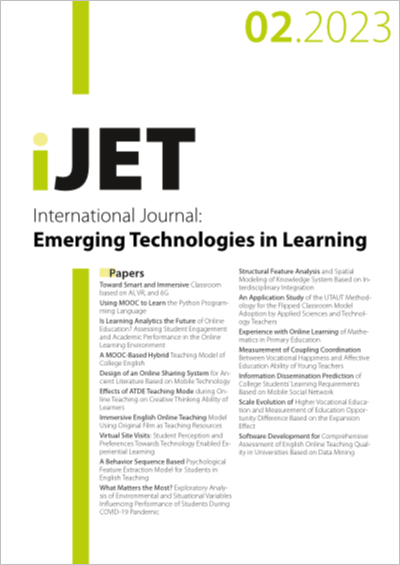Measurement of Coupling Coordination Between Vocational Happiness and Affective Education Ability of Young Teachers
DOI:
https://doi.org/10.3991/ijet.v18i02.37133Keywords:
young teacher, vocational happiness, affective education, coupling coordinationAbstract
When teachers are giving affective education, their emotional communication with students is a kind of state or process during which teachers’ work pressure can be alleviated when they are cultivating students’ sentiment, in the meantime, they also could attain positive mental quality and a sense of vocational happiness. Regarding the relationship between young teachers’ vocational happiness and their Affective Education Ability (AEA), only 1-2 articles have discussed it from the perspective of a single ability, there isn’t complete research on the AEA system of teachers. Therefore, to fill in this research blank, this paper aims to measure the coupling and coordination between the development of young teachers’ vocational happiness and their AEA, in the hopes of providing a piece of useful evidence for relevant research. The theory of emotional intelligence and positive psychology serve as the theoretical basis of this paper. In the second chapter, this paper builds a framework for young teachers’ affective education and an AEA training model, and employs Artificial Neural Network (ANN) to extract the time series data features of the divided six evaluation indexes of young teachers’ AEA. In the third chapter, this paper uses the Coupling Coordination Degree (CCD) to measure the coupling and coordination of the development level young teachers’ vocational happiness and their six kinds of AEA, and gives the quantification process. In the fourth chapter, this paper adopts the Grey Relational Analysis (GRA) to quantify the influence degree of all indexes on young teachers’ vocational happiness and their six kinds of AEA, thereby realizing the quantitative measurement of each evaluation index on the comprehensive development of the two. At last, experimental results are drawn to verify the measurement and analysis results of the coupling and coordination of the two.
Downloads
Published
How to Cite
Issue
Section
License
Copyright (c) 2022 Nan Zhang (Submitter); Mengnan Li

This work is licensed under a Creative Commons Attribution 4.0 International License.


